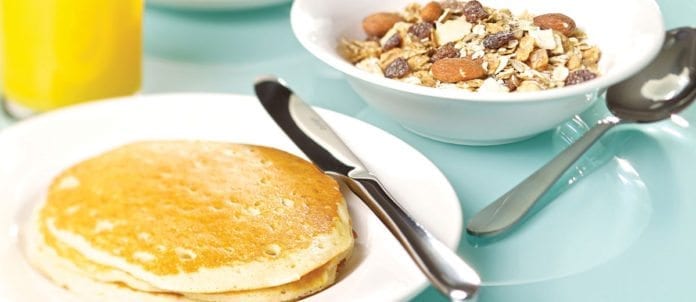It turns out you truly get what you pay for when it comes to tabletop wares, at least that’s the consensus among restaurateurs and suppliers. That’s not to say every item that graces a restaurant’s tabletop needs to be high-end. Rather, it’s a matter of picking and choosing where to invest. For some, quality stemware and cutlery are the wow factors that enhance the experience. For others, it pays to spend extra on branded linens and eye-catching plates.
Expert advice
For the most part, operators are thinking more strategically about their tabletops while keeping an eye on quality. “These items see abuse day in and out, so it pays to choose quality, traditional pieces that can be easily replaced,” explains Bill Horosko, president of Tableware Solutions in Mississauga, Ont.
Cutlery is one area where operators are willing to pay more. It helps that reasonable quality cutlery is now available at a lower price point. “[But, operators are] not getting cheap on cutlery. A lot tend to look for European, properly balanced type lines, from sandblasted to high-polished stainless-steel finishes,” Horosko says.
In terms of glassware, the majority of restaurant budgets tend to include the purchase of quality wine glasses as a means to educate customers and increase profits for a high-margin item. “Better quality stems bring a perceived value to the experience,” Horosko explains.
And, restaurant operators are increasingly accessorizing tabletops with non-traditional pieces such as stainless-steel baskets, coloured earthenware serving dishes and enamel-coated cast-iron pieces. “Baskets, wood and ceramic add another dimension and colour to tables,” Horosko explains. “We’re seeing it all the way through from casual, lower-priced restaurants to high-end five-star hotels. That’s where their personal signature is going.”
Some operators will even incorporate logos into selected tabletop items as part of their branding. For example, at La Société Bistro in Toronto, the eatery’s logo is imprinted on the rims of plates and edges of napkins. Service is augmented by interesting serving vessels such as miniature cast-iron skillets and french-fry pails. But, imprinting and glazing plates takes time (weeks) and can add to the cost substantially (at least double, depending on the graphics), according to Marlo Onilla, principal with Biography Design in Toronto. But, the choices you make depend on the concept you want to promote. “A Mexican restaurant is a lot more casual, for example, so you would see more cast iron and less expensive plates and cutlery,” says Onilla.
What’s more, portion control continues to be a concern for operators looking to increase margins; it’s leading to creative presentations. “Fry pails on a plate are a good vessel for portioning servings,” explains Scott Davidson, VP of Culinary Development for Crush Strategy Inc. in Burlington, Ont. “Any time you can build height and add dimension at a low cost it’s awesome.” For example, ceramic tasting spoons come at a fraction of the cost of two-ounce ramekins (25 cents instead of $2). And, bamboo skewers with curled tops offer a higher-end look and feel than frilled toothpicks.
One item of note that is gaining popularity on the pub scene is beer-flight paddles, Davidson notes. A common item in U.S. ale houses, these paddles are available in various shapes, sizes and finishes and are designed to hold multiple small glasses with indentations carved out for accompaniments, such as pretzels, dips or tapas.
Tried-and-true
At Cibo Trattoria and Uva Wine Bar in Vancouver, recent renovations extended to the tabletops where basic designs were instituted. “We used to have earthy type tones, because it was an Italian restaurant. But the chef wanted to use the white plates to make his food the star of the show,” says Steve Edwards, GM. While choosing simple whites seemed to be a simple decision at Cibo and Uva, choosing plates was more complicated. “We took the time to look at different suppliers, got samples and cooked with them to see how everything looked,” says Edwards. “One thing it had to be was durable.” The final decision for dishware was a line from Fortessa.
And, since the bar is an important part of the operation, glassware required extra consideration. One item of note is titanium-coated wine glasses from Schott Zwiesel. “The biggest thing for me is the tritan coating,” Edwards says. “It’s incredible, because it takes a lot more to break these glasses, and they cost a bit less.” For cocktails, he looks for tempered glass to withstand the high temperatures of the under-the-counter dishwasher. “If you don’t have tempered glass, glasses can get cracked and pop,” the GM explains. He also has a selection of Riedel and Spiegelau glassware, along with “little martini and cocktail glasses from flea markets.”
At the Union Social Eatery in Mississauga, Ont. and Toronto, the tableware needs are slightly different. “We put 3,000 people a week through our restaurant, so we need to make sure the table stuff fits with the times and has durability,” explains Steve Proulx, the owner of Union Social Eatery, and former VP of Canyon Creek, part of Burlington, Ont.’s SIR Corp. “When it comes to plateware, we looked for something sturdy and well-built that could [withstand] a lot of washes and handling but still be contemporary in looks and not over the top.” Given the restaurant has a wide selection of beers on tap, Proulx has an inventory of unique branded glasses he sources from his beer suppliers. When it comes to soft drink and water containers, he looks for durable glassware that isn’t too “chunky” and is comfortable to hold. Like many operators, he’s a proponent of quality wine glasses. Apart from stainless-steel ramekins and three-compartment ceramic dishes for holding condiments, Proulx’s not big on adding too many items to the table. “We try to make sure the food does the talking. The added touches are in the service,” he says.
But, simplicity doesn’t necessarily come cheap. Proulx estimates the tabletop budget for his new Toronto site was approximately $20,000. “We could have outfitted the tables for half of what we spent,” but we would have ended up with supply problems and products that wouldn’t last, he says. Regardless, the Union Social Eatery owner expects to replace up to 80 per cent of the plateware annually. As for cutlery, “We never know where that goes, but it tends to get turned over once throughout
the year.”
Of course, ease of replacement is a big part of the buying decision when it comes to tabletop accoutrements. “You have to know this stuff is available and that there won’t be issues on the supply side, which is why we go local where we can,” says Proulx.





















